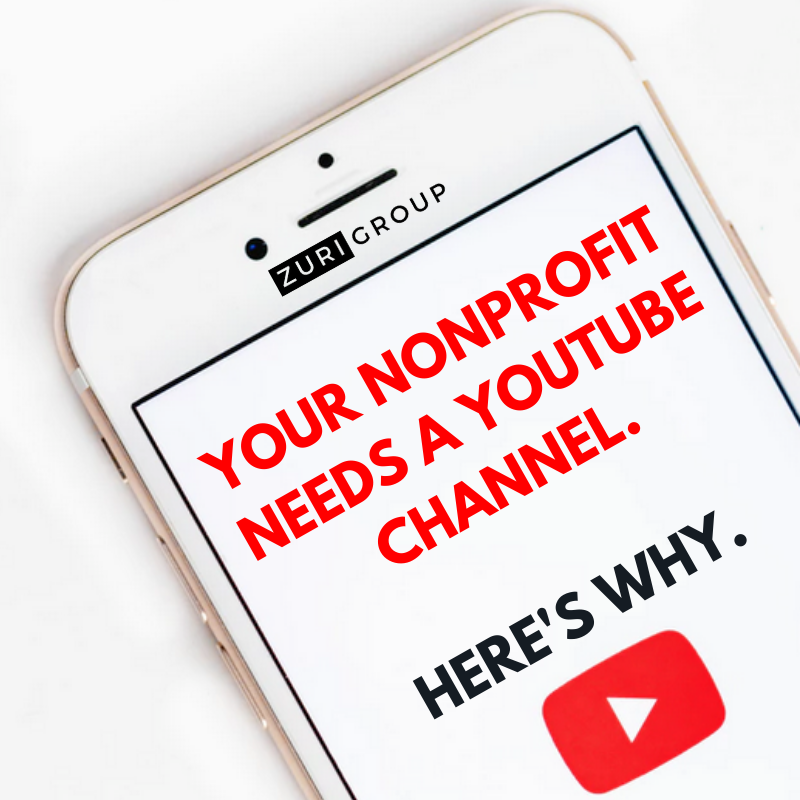YouTube should be a part of your digital strategy, which means that your nonprofit needs a YouTube channel.
If you just heard an internal record-scratching sound and thought ‘We really don’t have the budget, the time, or the experience to create video content on a regular basis. I think we’re going to pass on this.’ – stay with me a moment!
Let me reassure you that:
- You don’t need any special camera equipment, videography experience, or fancy graphics.
- You don’t need an upload schedule.
- You don’t have to become a full-time YouTuber.
If you’ve got a compelling story about your organization’s mission and a smartphone – you’re halfway there!

Why does my nonprofit need a YouTube channel?
Here’s why:
- YouTube is the second largest search engine, processing more than 3 billion searches a month. If you’re not utilizing YouTube, you’re missing out on a key opportunity to boost your SEO and ensure that users can find your organization, regardless of how they’re searching.
- 1.5 billion people coming to the platform every single month – that’s the equivalent of one in every five people around the world!
- YouTube reaches more 18 to 34-year-olds than any cable network in the U.S., making it a great way to expand your reach and connect with a younger audience, for free.
- Videos are a great way to emotionally connect with your audience and spur them to action.
- YouTube is the place where the most video is consumed every day. On average, viewers spend over an hour a day watching YouTube on mobile devices alone.
What kinds of videos should my nonprofit share on YouTube?
Inspire: Whether you’re looking to get people to donate, sign up for a peer-to-peer or DIY fundraising event, sign a petition, or find another way to get invovled – YouTube videos are a great medium for you to help inspire people to take action on behalf of your mission.
Thank: What’s on your ‘thank you’ page after supporters have taken action? Consider putting together a ‘thank you’ video that you can embed on that page so that they know right away how much you appreciate the impact that they’ve made.
Raise Awareness: Consider putting together a video that explains your mission in story form. This is a great piece of evergreen content that you can use on your website to reinforce your messaging and provide another way for users to interact with your site and your content.
Update: Videos are a great way to provide status updates on fundraising initiatives and impact stories. And they’re reusable! They can be embedded on your website, shared on social, and used in email campaigns.
Getting started
Learn the Basics: From the fundamentals of video content to the tactical implementation of creating your channel and lessons on storytelling and growing your audience – the YouTube Social Impact site has a ton of great resources to help you get started so that your channel is set up for success.
Get Inspired: You don’t have to reinvent the wheel! There are some great examples of successful videos and campaigns that other nonprofits have run on the YouTube platform that you can borrow from or use to help jumpstart your creative process.
Create Your Content: Even without video editing experience, you can easily create videos in programs like Movavi (for Windows) or iMovie (for Mac). You can even use free online tools like Canva to create interstitial titles for your videos. (I created the featured video for this blog post using smartphone video and photos, iMovie, Canva, and royalty-free music that I found on YouTube – and I have no background in graphic design or videography – so trust me when I say that it’s easy!)
Don’t Forget the Keywords: YouTube is a search engine, so make sure that your title, description, and tags are keyword optimized so that the algorithm will serve up your video when users search relevant terms.
Give Your Website an SEO Boost: Since Google owns YouTube, embedding YouTube video on relevant pages of your website can help strengthen your Google search results page ranking. So don’t forget to embed your videos on your site!
Consider Accessibility: While video content is more engaging than standard text and can give visually impaired users a level of access to your content that they may not have if your site is not ADA accessible, it can be easy to overlook other accessibility issues. Make sure that you upload a transcript of your video – especially if there is no audio – so that users with screen readers can still have access to your content.
It can feel scary to try something new, but I’m hopeful that the low barrier to entry combined with the long-term benefits to your organization will encourage you to give YouTube a try.
I can’t wait to see what you create!
 Lorealle Bishop is a marketing consultant here at Zuri Group. She understands the impact that messaging can have at every touchpoint of the user journey and helps organizations build a communication strategy that reflects their core values and supports their business goals.
Lorealle Bishop is a marketing consultant here at Zuri Group. She understands the impact that messaging can have at every touchpoint of the user journey and helps organizations build a communication strategy that reflects their core values and supports their business goals.
